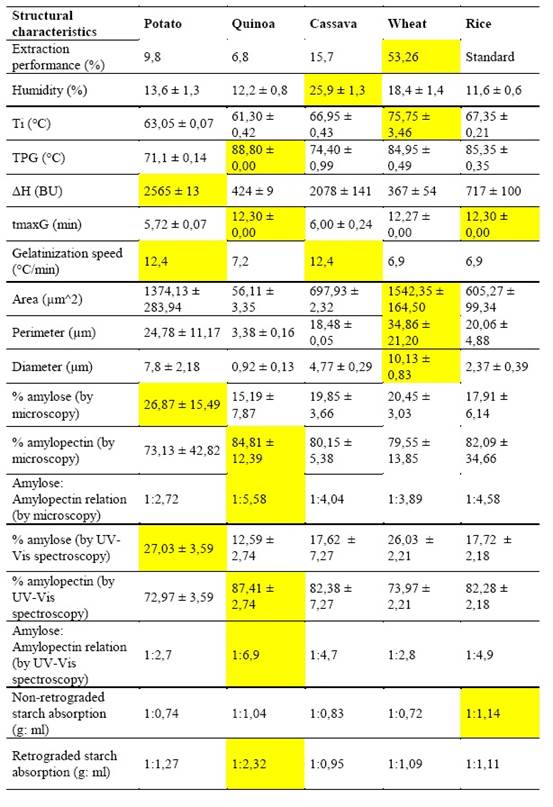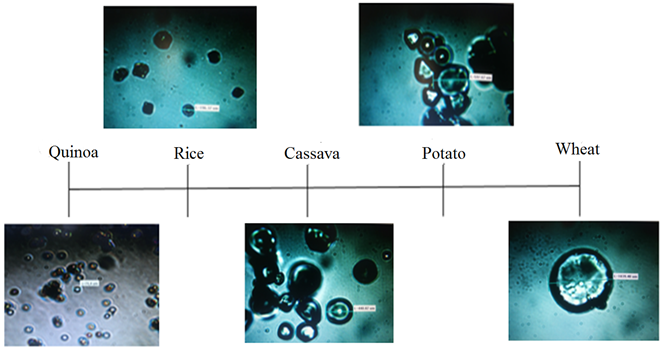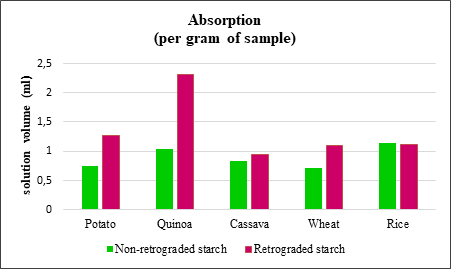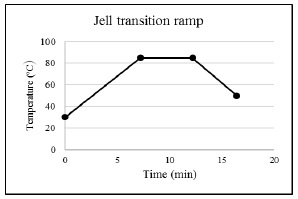INTRODUCTION
The natural polymers called carbohydrates are polysaccharides, which are naturally degradable macromolecules (biodegradable) 1),(2. One of the most important natural polysaccharides is starch 4, granules composed of two polymers of glucoses: amylose and amylopectin found in food grains 4),(5.
Amylose is a linear polymer of glucose units linked by α (1-4) glycosidic bonds, in which some α (1-6) bonds may be present. Amylopectin is a branched polymer of glucose units linked in 94-96% by α (1-4) bonds and 4-6% with α (1-6) bonds 6.
Starch granules can be found in a semicrystalline polymer system, where the crystallinity varies from 15 to 45%. The crystalline and the non-crystalline areas have a concentric arrangement. The branching points of amylopectin correspond to amorphous areas 7),(8.
The morphology, chemical composition, and supramolecular structure of starch granules are important characteristics that affect their functional properties 9. In addition, starches of different botanical origin show variation in their chemical and structural composition which influences their properties and functionality 10.
The use of starch in different industrial applications depends on properties such as gelatinization, amylose and amylopectin content, retrogradation, moisture, absorption particle size and surface area 11. These structural characteristics may have a close relationship with each other. In this way, the use of starches as absorbents is restricted by their structural characteristics.
Absorbent polymers are materials that can absorb and retain large amounts of water or aqueous solutions. These polymers consist of hydrophilic monomers that make up a three-dimensional network 12),(14. In the case of starch, hydroxyl groups favor the absorbent capacity 15.
RESULTS AND DISCUSSION
The results of the analysis of extraction performance, humidity, gelatinization, granule morphology, rate amylose - amylopectin and absorption realized on five starches of different botanical origin, are shown in (Table 1).
Quinoa starch had the lowest extraction yield. Quinoa contains very low percentage of water in its structure and a high percentage of protein and lipid, which can hinder the extraction process. Quinoa starch was found to be in the inner part of the pseudocereal (Perisperm) 16 whereas in the case of wheat, starch is found on the outside of the cereal (Endosperm) 17. Therefore, it is likely that the low yield in quinoa starch extraction is due to this characteristic.
The moisture value of each sample is one of the variable that impact the gelatinization characteristics. For example, Cassava starch, with the highest percentage of moisture, is one of the highest gelatinization.
The samples with better gelatinization are starches of the potato and cassava. According to the results, the samples with less gelatinization are wheat, quinoa and rice; those samples need higher temperature to reach this condition.
Table 1 Results of analyzes performed on potato starch, quinoa, cassava, wheat and rice as standard sample. The results are shown with their standard deviation and propagation of errors when they are numbers calculated from a calibration curve.

Maximal values. BU = Brabender units, arbitrary units of the equipment used; Ti is the start temperature of gelatinization; TPG is the temperature at which the maximum gelatinization is reached; ΔH is maximum gelatinization; tmaxG is the time in which the maximum gelatinization is reached
Starch retrogradation occurs through a previous gelatinization process, which requires knowing the gelatinization characteristics of each starch.
The results on the tests of the absorbent capacity of each starch are shown in figure 2:
According to literature, high transition temperatures have been related to a high degree of crystallinity, indicating structural stability and resistance of gelatinization granules 18. As seen in table 1 and figure 1, quinoa starch is the smallest and the one that contains the highest percentage of amylopectin. Wheat starch is the largest and has one of the lowest percentages of amylopectin in relation to the others. As can be seen in figure 2, retrogradation favors the absorbent capacity of starches; with the exception of rice starch.
EXPERIMENTAL
For the extraction of starch, modified methods mentioned in different works and articles were used (19)-(21). A modified Vansteelandt and Delooar method was employed for wheat starch.
The humidity of 0.2 g samples was determined in a moisture balance Radwag MAC 110 / WH . four times each.
Gelatinization thermograms were done in a micro visco amylograph Brabender The analysis was performed twice for each starch and the average was reported. The temperature ramp used was as follows:
Microscope B-350 OPTIKA was employed to observe granules of each starch. Perimeter, area, diameter, and percentage of amylose and amylopectin were the values observed from the images obtained, three times each
Amylose and amylopectin quantification was by Aristizábal and Sánchez method (22). It is a spectrophotometric method that measures the absorbance of the iodine-starch complex at 620 nm and is only used up to a percentage of 40% amylose. The amylopectin content was calculated by subtracting the amylose content. A calibration curve is obtained by plotting concentration vs. absorbance at 0%, 10%, 20%, 25%, 30% amylose in a (Micro miu) uQuant BIOtek, USA spectrophotometer using solutions of sodium hydroxide, ethanol (95%), sodium hydroxide (0.09M), acetic acid (1M) and lugol (2%), five times for each starch.
Retrograded starches came from the gelatinization process with a magnetic stirrer MS H280 Pro. Subsequently, the gelatinized starches were put into an oven at 80 ° C until dryness. Finally, the retrogradation of the starches was submitted to a microscope evaluation.
For the absorption tests, considering its possible industrial application, we employed a solution of sodium chloride (3%) and citric acid (1%).
In order to determine the maximum volume of solution that starch samples absorb, the ratio between starch and absorbed volume was determined from 1 g of each starch, in non-retrograde and retrograded state.
CONCLUSIONS
The retrograded quinoa starch is the one with the maximum absorbent capacity. The granule of this starch is the smallest one, has the highest ratio of amylose and amylopectin or highest percentage of amylopectin, and a low degree of gelatinization. These structural characteristics allow its high degree of absorption. In this starch, retrogradation favors absorption due to the breakdown of the granules, resulting in a greater contact surface which generates greater contact with the amylopectin structure; this fact causes water molecules to be more easily retained in the structure, and hydrogen bonds are formed.












 uBio
uBio 




